Starting your first freshwater aquarium is an exciting journey. With the right preparation and knowledge, you can create a thriving aquatic environment that brings life and beauty to your home. This guide will walk you through every step, from choosing the right tank to adding your first fish.
Step 1: Choose the Right Aquarium
The size and type of aquarium you choose are critical to your success as a beginner.
• Tank Size:
A 20–30 gallon tank is ideal for beginners. It’s large enough to provide stability in water conditions but not too overwhelming to manage.
• Material:
Glass tanks are sturdy and scratch-resistant, while acrylic tanks are lighter and more customizable.
Pro Tip:
Avoid starting with tanks smaller than 10 gallons. Smaller tanks are harder to maintain due to rapid fluctuations in water parameters. And it’s also not nice for the fish.
The Tetra 20 Gallon Tropical kit is a fantastic choice for beginners, offering a proper tank size, reliable equipment, and easy setup.

Step 2: Select the Right Location
Pick a location that’s:
• Away from direct sunlight to prevent algae growth.
• Close to an electrical outlet for equipment.
• On a sturdy surface capable of supporting the weight of a filled tank.
Remember that 1 gallon of water weighs approximately 8.34 pounds, so plan accordingly.
Step 3: Gather the Necessary Equipment
Here’s a checklist of essential equipment for your freshwater aquarium:
1. Filter: Removes debris, toxins, and excess waste. A hang-on-back or canister filter is ideal for beginners.
2. Heater: Maintains a stable temperature, usually between 74–80°F for most tropical fish.
3. Lighting: Enhances visibility and supports plant growth if you’re including live plants. LED lights are energy-efficient and long-lasting.
4. Substrate: Gravel or sand, depending on your preference and the needs of your fish.
5. Water Conditioner: Neutralizes chlorine and other harmful chemicals in tap water.
6. Test Kit: Measures pH, ammonia, nitrite, and nitrate levels to monitor water quality.
7. Thermometer: Ensures the water stays within the correct temperature range.
8. Net and Gravel Vacuum: For cleaning and maintenance.
Optional:
If you’re adding live plants, consider a CO2 system and fertilizers for optimal growth.
Step 4: Set Up the Aquarium
1. Rinse the Tank and Equipment:Rinse everything with warm water to remove dust. Avoid using soap or chemicals, which can harm fish.
2. Add the Substrate:
Spread 1–2 inches of substrate evenly across the bottom. Rinse the substrate first to prevent cloudiness.
3. Position Decorations:
Arrange rocks, driftwood, and plants. These provide hiding spots and reduce stress for fish.
Step 5: Fill the Tank with Water
• Use a clean bucket or hose to fill the tank with room-temperature water.
• Add a water conditioner to remove harmful chemicals like chlorine and chloramine.Pro Tip:
Place a plate or bowl on the substrate while pouring water to prevent disturbing it.
Step 6: Install Equipment
1. Filter: Attach and prime the filter according to the manufacturer’s instructions.
2. Heater: Place the heater near the filter outlet to distribute warm water evenly.
3. Lighting: Install the light and adjust it for a 6–8 hour daily schedule.Check that all equipment is functioning properly before moving to the next step.
Step 7: Cycle the Aquarium
Cycling establishes beneficial bacteria that break down fish waste into less harmful substances. This is crucial to prevent “new tank syndrome,” which can kill fish.
• Add a bacterial supplement or ammonia source to start the cycle.
• Test the water every few days to monitor ammonia, nitrite, and nitrate levels.
• Wait 4–6 weeks until ammonia and nitrite levels drop to zero, indicating the tank is fully cycled.
Pro Tip:
Patience is key. Don’t add fish before the tank is fully cycled.
Step 8: Choose the Right Fish
For beginners, opt for hardy, community-friendly fish such as:
• Neon Tetras
• Guppies
• Corydoras Catfish
• Mollies
• Zebra Danios
Research each species to ensure compatibility and understand their care requirements.
Stocking Rule:
Follow the “1 inch of fish per gallon” rule as a general guideline, keeping in mind adult sizes.
Step 9: Acclimate Your Fish
• Float the fish bag in the tank for 15–20 minutes to match water temperatures.
• Gradually add small amounts of tank water to the bag over 30 minutes.
• Gently release the fish into the tank using a net.Avoid adding store water to your aquarium, as it may contain contaminants.
Step 10: Maintain Your Aquarium
Regular maintenance is key to keeping your fish healthy:
• Weekly Water Changes: Replace 10–25% of the water to remove waste and maintain water quality.
• Test Water Parameters: Use your test kit weekly to ensure levels are safe.
• Clean the Filter: Rinse filter media in tank water during water changes.
Pro Tip:
Observe your fish daily for signs of illness or unusual behavior.
Final Thoughts
Setting up your first freshwater aquarium is a rewarding experience. By following these steps, you’ll create a healthy and vibrant habitat for your aquatic pets. Remember, the key to success is preparation, patience, and consistent care. Enjoy your new aquarium adventure!
